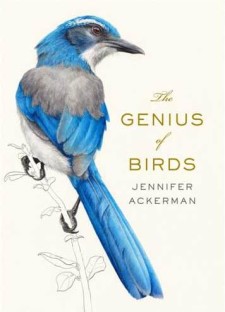Reviewed by Grant McCreary on November 21st, 2016.
For me, the enjoyment of birds started with identification – finding birds and figuring out what they were. But after a while, I found even greater joy in learning about the birds themselves. How do they spend their time? Why do they sing so gloriously? What are they thinking? (Do they think?) The more I learned, the more amazing birds became in my eyes. Whether you know nothing about birds or are a long-time student of them, you too will be amazed by what you learn in The Genius of Birds.
Ok, birds may be amazing. They may even be smart. But genius? The author clarifies this for us: “In this book, genius is defined as the knack for knowing what you’re doing – for ‘catching on’ to your surroundings, making sense of things, and figuring out how to solve your problems.” And birds certainly have problems to solve. They need to find food, find mates, and find their way during migration. And they have to do all that while adapting to changes we humans have wrought. Ackerman tells “the story of birds with extraordinary abilities or skills” in six areas: technical, social, musical, artistic, spatial, and adaptive.
“Technical” skills, such as tool making, are probably what come to mind first when thinking of bird smarts. Any discussion of tool making in birds has to begin with New Caledonian Crows. These crows, found only on a small Pacific island, are famous for their problem-solving ability. In the wild, they are known to fashion tools out of twigs in order to retrieve wood-boring grubs that would otherwise be inaccessible. In the lab, they can devise and perform multi-step processes to get to food. The author summarizes what has been observed of these birds, some of which may be familiar. She goes on, however, to give much more information, such as how it is these crows are able to perform such feats. A plausible reason is that they live on an island with very few predators. This affords them the opportunity to study, which is critical because it takes them over a year to learn how to fashion and use the tools effectively. “The island does its part by allowing [a young crow] to spend long hours of his young life honing his skills, moving gradually from bumbling apprentice to amateur tinkerer to expert toolmaker without interruption from, say, death.” But, as the book points out, there are still many unanswered questions, not the least of which is: “Which came first, the crow’s remarkable tool use or its exceptional intelligence?”
The other chapters, even if they don’t initially seem like they would, also demonstrate the intelligence and adaptability of birds. For example, it’s widely known that some birds are extremely social. But why? The author explains that social birds “can exploit information offered by other birds. This includes parents and peers and even other birds.” Note that last part – Ackerman provides several examples of birds basing their own behavior on the actions of other species. That level of cognition isn’t something usually ascribed to “lower” life forms.
One thing I love about studying birds is that you learn about much more than just birds, sometimes even about ourselves. A great example is found here in the chapter on navigation. Birds, specifically pigeons, “with experience navigating had a hippocampus more than 10 percent larger than the inexperienced birds.” The hippocampus is the part of the brain, in both birds and humans, that helps to orient in space. So if pigeons who exercised their navigational skills increased their navigational capacity, does the same thing happen in people? Turns out, it does. This brings up, as Ackerman puts it, “a troubling question”: “If our human navigational efforts shape our hippocampus, what happens when we stop using it for this purpose – when we lean too hard on technology such as GPS, which makes navigation a brain-free endeavor?” The answer is simple: if you don’t use it, you lose it.
If you read about birds extensively, you may wonder if you already know most of what’s contained here. I had that concern and, honestly, the first few chapters did little to change that. I was especially dubious when I came across a reference to “marsh hawk” (the old name for Northern Harriers) and a few other questionable statements. However, as I read more I found myself getting more interested. Thankfully, my concern ended up being unfounded – I did learn a great deal. Ackerman includes lines of research that I had not been aware of, and for those that I was elaborates more fully. For example, she mentions the famous British tits that learned to open milk bottles. Many know about that. But she goes further, describing a more recent, ingenious study. It sought to answer how such learning spreads through the population. Of the many results, it showed that “Birds, like humans, seem to be conformists.”
Recommendation
I love birds – and bird books – in part because there is always more to learn. This is exemplified in The Genius of Birds. Whether you are just starting to discover birds or already know them well, there is much to learn from this book. And marvel at – the cognitive ability of birds profiled here is nothing short of amazing. One thing is certain, you’ll never use “bird brain” as a slur again.
Disclosure: I get a small commission for purchases made through links in this post.
Buy from NHBS
(based in the U.K.)
Disclosure: The item reviewed here was a complementary review copy provided by the publisher. But the opinion expressed here is my own, it has not been influenced in any way.




Comment